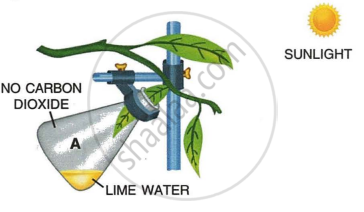Advertisements
Advertisements
प्रश्न
Chlorophyll is necessary for photosynthesis.
उत्तर
The chlorophyll traps solar energy and converts it into chemical energy.
APPEARS IN
संबंधित प्रश्न
The diagram is set up to demonstrate an experiment. Pond weed was placed in five water-filled tubes. The experiment was set up as shown in the diagram. The tubes were then left for 24 hours. Write the correct answer out of the five available choices:
(i) In which tube would you except to find the plant with the least amount of starch?
(a ) 1 (b) 2 (c) 3 (d) 4 (e ) 5
(ii) The tube in which most oxygen would be found is
(a ) 1 (b) 2 (c) 3 (d) 4 (e ) 5
(iii) The tube in which least carbon dioxide would be found is
(a ) 1 (b) 2 (c) 3 (d) 4 (e ) 5
(iv) The tube in which the plant would survive for the shortest length of time is
(a ) 1 (b) 2 (c) 3 (d) 4 (e) 5

Are the following statement true or false? Give a reason in support of your answer.
Destarching of the leaves of a potted plant can occur only at night.
Given below is the representation of a certain phenomenon in nature. With four organisms 1-4.

Name the biological process which was the starting point of the whole chain.
Given alongside is the diagram of an experimental set-up:

- What is the objective of this experiment?
- Will it work satisfactorily? Give reason.
- What alteration(s) will you make in it for obtaining expected result?
- Would you take any steps before starting the experiment? Describe this step and explain its necessity.
The diagram below shows two test-tubes A and B. Test-tube A contains a green water plant. Test-tube B contains both a green water plant and a snail. Both test-tubes are kept in sunlight. Answer the questions that follow:

(a) Name the physiological process that releases the bubbles of oxygen.
(b) Explain the physiological process as mentioned above in (a).
(c) What is the purpose of keeping a snail in test-tube B?
(d) Why does test-tube B have more bubbles of oxygen?
(e) Give an example of a water plant that can be used in the above experiment.
(f) Write the overall chemical equation for the above process.
Where are the chlorophyll pigments present in a cell?
Name the following:
The site of light reaction in the cell of a leaf.
Give technical term:
Name only one plant, you are familiar with which has no chlorophyll.
Give technical term:
Name the experiment to demonstrate the importance of light for photosynthesis.
Choose the correct answer:
Chlorophyll is present
